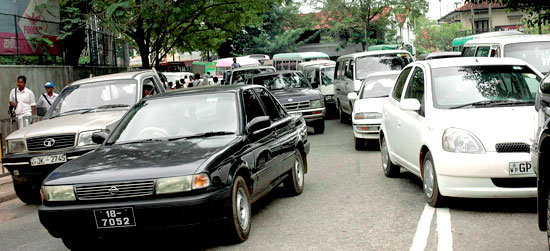Strategic plan to ease city trafficcongestion
Mixed reactions from business community
By Lalin Fernandopulle
[email protected]
The Ministry of Transport is formulating a transport policy to reduce
the number of vehicles coming to Colombo to minimise traffic congestion,
save fuel consumption and reduce air pollution.
 The proposed strategic plan for traffic management in the city
targets to reduce the number of private vehicles from 175,000 to 125,000
by the end of 2010. This will improve traffic speed by 50 percent and
the impact of air pollution by half. The proposed strategic plan for traffic management in the city
targets to reduce the number of private vehicles from 175,000 to 125,000
by the end of 2010. This will improve traffic speed by 50 percent and
the impact of air pollution by half.
Director Planning, National Transport Commission (NTC), Namali
Siyambalapitiya said the proposed plan will help to reduce the number of
private vehicles coming to Colombo daily and ease traffic congestion and
the impact of air pollution.
"Most cities are now following the transport demand management
strategy to provide an efficient transportation due to the constraints
of road space in the city", Siyambalapitiya said.
Colombo being the hub for commercial activities with the port and
other key business establishments, the number of vehicles entering the
city has increased over the years.
Over the past 30 years the number of trips made by cars and
motor-cycles has increased from 5 to 20 per cent leading to an explosion
in demand for road space from 25,000 to 175,000 vehicles per day.
According to NTC reports 830,000 people visit Colombo daily and of it
90 per cent use road transportation while around 10 per cent use trains.
Around 200,000 are private vehicles of the 225,000 vehicles that
enter the city on a working day. The number of buses that enter the city
is 10,000 and the number of heavy vehicles is 15,000.
Though the number of people travelling to Colombo during the past
decade had dropped the number of vehicles has increased which shows that
people have shifted from public transportation to private vehicles. The
growing number of private vehicles has created space limitations on
roads causing congestion. Increasing the number of railway passengers to
120,000, a 50 per cent increase by end 2010, reducing the number of
goods vehicles, rerouting of buses, ensuring that at least one-third of
the road space on major highways within a 10 kilometre radius from
Colombo Fort and within the city be reserved for high occupancy vehicles
are being looked into under the traffic management plan.
A premium bus service commencing from various locations for car
owners will be introduced as an optional medium term plan.
There has been mixed reactions from the business community on the
proposed traffic management plan.
Managing Director Chevron Lubricants Lanka PLC, Kishu Gomes said a
proper transportation system which will enhance productivity is
essential and not alternative measures which are not practical.
"Prospective investors will lose confidence on a poor transportation
system with logistical problems ", he said.
Chairman, Joint Business Forum, Nimal Perera said that the forum had
proposed to increase the frequency of railway services with better
facilities and set up terminals at the entrance to the city.
"The forum is studying the feasibility of adopting flexible working
hours to ease traffic congestion", Perera said. Partner, Gajma and
Company Ltd. N. R. Gajendran said there should be a structured plan that
will resolve issues and provide better transportation. Shortcut
solutions will not help to develop transportation.
The strategic plan was formulated by the NTC last year following a
Supreme Court case pertaining to the reduction of the number of vehicles
entering the city and reduction of emission levels. |
